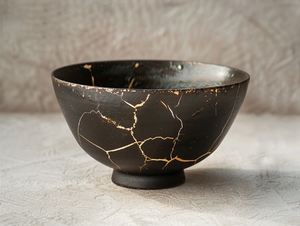Kuro Satsuma

Kuro Satsuma (黒薩摩) is a type of traditional Japanese pottery that originated in the Satsuma Domain. Renowned for its deep black glaze and rustic elegance, Kuro Satsuma ware represents one of the two main styles of Satsuma ware (薩摩焼, Satsuma-yaki), the other being Shiro Satsuma (white Satsuma). It has historically been associated with everyday use, particularly among samurai and common folk.
History
Origins
Kuro Satsuma dates back to the late 16th to early 17th centuries, during the Azuchi–Momoyama period and early Edo period, following the Japanese invasions of Korea (1592–1598). During this time, potters from Korea were brought to Japan by Shimazu Yoshihiro, the feudal lord of Satsuma, and were settled in various kiln villages throughout the region.
These Korean artisans introduced advanced techniques in ceramic production, which laid the foundation for both the white and black styles of Satsuma ware.
Evolution
While Shiro Satsuma became known for its ivory-colored glaze and fine overglaze enamel decoration intended for the elite and export, Kuro Satsuma remained grounded in local, utilitarian traditions. It evolved primarily as a practical ware for use in the daily lives of locals, especially for tea bowls, sake bottles, and storage jars.
Characteristics
Materials
- Clay: Iron-rich local clay from Kagoshima and surrounding areas
- Glaze: A high-iron content glaze that creates a deep, glossy black finish
- Firing: Typically fired in climbing kilns (noborigama) at high temperatures
Appearance
- Color: Rich black glaze, often with brown, reddish, or purplish undertones
- Texture: Rough and earthy due to the iron content and traditional shaping methods
- Decoration: Typically minimal, though some pieces feature simple incised patterns or natural ash glazing
Uses
Kuro Satsuma ware was traditionally used for:
- Everyday dining vessels such as bowls and plates
- Tea utensils, particularly in rustic-style tea ceremonies
- Sake flasks (tokkuri) and cups (guinomi)
- Storage jars for food and liquids
It embodies the aesthetics of wabi-sabi, emphasizing simplicity, imperfection, and connection with nature.
Kilns and Production Centers
Notable production areas for Kuro Satsuma include:
- Ryumonji Kiln (龍門司窯) – One of the oldest and most famous kilns producing Kuro Satsuma
- Naeshirogawa Kiln – Known for both black and white Satsuma styles
- Tateno Kiln – Contributed to the development of early styles
These kilns often operated in small rural communities and passed down their techniques through generations.
Cultural Significance
Kuro Satsuma holds cultural value as a form of mingei (folk craft) (民芸, mingei) in Japan. It has been recognized for its:
- Historical continuity from the Edo period to the present
- Role in regional identity of Kagoshima
- Integration into Japanese tea culture
Today it is appreciated by collectors, tea practitioners, and those interested in Japan’s regional pottery traditions.
Modern Revival and Preservation
Efforts have been made in recent decades to revive Kuro Satsuma:
- Local artisans continue to produce it using traditional methods
- Craft preservation societies and museums in Kagoshima promote its legacy
- Workshops and exhibitions help educate the public and encourage younger generations to learn the craft
See Also
References
- Kato, Tokuro. The Traditions of Japanese Pottery. Tokyo: Kodansha International, 1980.
- Japan Folk Crafts Museum. Catalogue of Regional Ceramics. Tokyo, 1998.
- Kagoshima Prefectural Government. Cultural Properties of Satsuma, official publication.
Audio
| Language | Audio |
|---|---|
| English |
